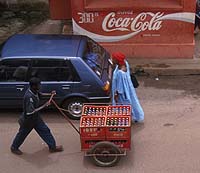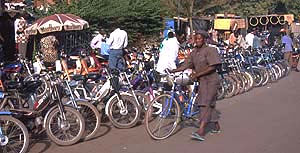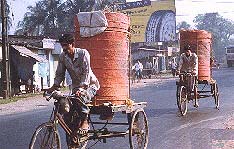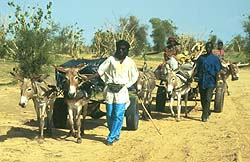|
|
Some
technologies spread 'spontaneously'
|
| If a
transport technology is appropriate and profitable, rapid adoption
is possible within one generation. Government funding and promotion
are not prerequisites for rapid adoption. Entrepreneurs can establish
manufacturing facilities and supply systems involving formal and informal
trading systems. |

A private sector transport technology
in Guinea |
|
Some technologies spread rapidly
and 'spontaneously'
Most transport technologies
have been developed and spread by entrepreneurs and users and not
by public sector services. This applies to the historical development
and spread of wheelbarrows, animal-drawn carts, bicycles, cycle
rickshaws and motorcycles.
|

Parking for mopeds and bicycles in Burkina
Faso where cycle technology has spread rapidly in recent years
|
|

Load-carrying tricycles (cycle rickshaws)
in India
|
|
Development and spread of
cycle rickshaws
Rickshaws are two-wheel carts pulled by a person. Cycle rickshaws
are tricycles originally derived from a bicycle front and a rickshaw
rear. On the Indian subcontinent they have been used for over sixty
years. Over six million of them, made and operated by entrepreneurs,
transport people and goods. Cycle rickshaw success is due to its
transport value, relative simplicity and low cost, ease of local
manufacture and repair and ease of use. Engineers claim the existing
designs are poor, with inefficient gearing, unnecessary weight,
poor steering geometry, lack of suspension, weak wheels and inadequate
brakes. Several recent initiatives
in India and Bangladesh have aimed to improve operator comfort and
technical efficiency. The numerous small entrepreneurial manufacturers
could rapidly copy and disseminate new designs if suitable components
were available and if the rickshaw users demanded them. However,
to date, the 'improved' designs have yet to be widely manufactured
and adopted.
|
|

Donkey carts used for transport to market
in Mauritania
|
|
Spread of donkey carts in Mauritania
Pack donkeys have been
used for centuries in Mauritania to transport water, goods and
people. Until recently, there were few carts (fewer than 1000
carts were used in 1960). Lately, there has been a large expansion
in carts pulled by donkeys and horses. Over 75,000 donkey carts
are now used. This
rapid increase has been due to entrepreneurial activity, not government
intervention. The carts or their components derive from workshops
in Senegal and Mali. Some
complete carts have crossed
over the southern border, but most have been made from components
in small workshops. Carts cost US$ 180-260, implying that some
US$ 15 million has been invested in carts in 20 years. Credit
for carts has been minimal. Urban transporters and rural families
have found cart investment profitable. The carts have increased
the capacity of donkeys to transport water, forage, agricultural
produce, building materials, traded goods, people and urban waste.
Donkey carts are now important in the urban and rural economies
of Mauritania.
|
|

